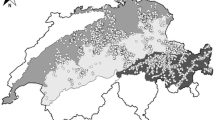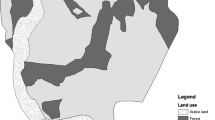Abstract
The vegetation characteristics and habitat selection associated with the bed-sites used by neonatal roe deerCapreolus capreolus (Linnaeus, 1758) fawns were studied in an agricultural environment in central Norway. Data were collected from 85 radio-collared fawns belonging to 38 families during 1992–1994. All bed-sites used provided effective cover, although this differed between habitats and increased during the summer as the herbaceous vegetation developed. Seasonal use of farmland increased and then decreased reflecting the growth, and cutting of the grass. Habitats were not used in relation to their availability. Early born fawns significantly avoided farmland, whereas later born fawns showed no significant selection or avoidance of any habitats. The data show how roe deer fawns are able to exploit small patches of non-cultivated habitats in an agricultural landscape.
Similar content being viewed by others
References
Aanes R. and Andersen R. 1996. The effects of sex, time of birth, and habitat on the vulnerability of roe deer fawns to red fox predation. Canadian Journal of Zoology 74: 1857–1865.
Aebischer N. J., Robertson P. A. and Kenward R. E. 1993. Compositional analysis of habitat use from animal radio-tracking data. Ecology 74: 1313–1325.
Alldredge A. W., Deblinger R. D. and Peterson J. 1991. Birth and fawn bed site selection by pronghorns in a sagebrush-steppe community. The Journal of Wildlife Management 55: 222–227.
Andersen R. and Linnell J. D. C. 1997. Variation in maternal investment in a small cervid; the effects of cohort, sex, litter size and time of birth in roe deer (Capreolus capreolus) fawns. Oecologia 109: 74–79.
Andersen R. and Linnell J. D. C. 1998. Ecological correlates of mortality of roe deer fawns in a predator-free environment. Canadian Journal of Zoology 76: 1217–1225.
Andersen R. and Linnell J. D. C. 2000. Irruptive potential in roe deer: density dependent effects on rate of increase and fecundity. The Journal of Wildlife Management 64: 698–706.
Austrheim G. 1995. Vegetation on Storfosna, South Trøndelag. Vegetation mapping and biomass estimation as background for study in roe deer. Norwegian Institute for Nature Research Fagrapport 9: 1–36. [In Norwegian with English summary]
Barrett M. W. 1981. Environmental characteristics and functional significance of pronghorn fawn bedding sites in Alberta. The Journal of Wildlife Management 45: 120–131.
Bodie W. L. 1979. Factors affecting pronghorn fawn mortality in central Idaho. MSc thesis, Univeristy of Montana, Missoula.
Borg K. 1991. [Roe deer: causes of death, effects of environment and forensics]. Swedish Nature Protection Agency Report 3921: 1–108. [In Swedish]
Bowyer R. T., Kie J. G. and Van Ballenberghe V. 1998. Habitat selection by neonatal black-tailed deer: climate, forage, or risk of predation? Journal of Mammalogy 79: 415–425.
Byers J. A. and Byers K. Z. 1983. Do pronghorn mothers reveal the locations of their hidden fawns? Behavioral Ecology and Sociobiology 13: 147–156.
Canon S. K. and Bryant F. C. 1997. Bed-site characteristics of pronghorn fawns. The Journal of Wildlife Management 61: 1134–1141.
Espmark Y. 1969. Mother-young relations and development of behaviour in roe deer (Capreolus capreolus L.). Viltrevy 6: 461–540.
Fitzgibbon C. 1993. Antipredator strategies of female Thomson’s gazelles with hidden fawns. Journal of Mammalogy 74: 758–762.
Gaillard J. M. and Delorme D. 1989. Selection of bed sites by juvenile roe deer (Capreolus capreolus). Acta Oecologica/Oecologia Generalis 10: 411–418. [In French with Englih summary]
Gerlach T. P. and Vaughan M. R. 1991. Mule deer fawn bed site selection on the Pinon Canyon maneuver site, Colarado. Southwestern Naturalist 36: 255–258.
Hewison A. J. M., Vincent J. P., Joachim J., Angibault J. M., Cargnelutti B. and Cibien C. 2001. The effects of woodland fragmentation and human activity on roe deer distribution in agricultural landscapes. Canadian Journal of Zoology 79: 679–689.
Huegel C. N., Dahlgren R. B. and Gladfelter H. L. 1986. Bed-site selection by white tailed deer fawns in Iowa. The Journal of Wildlife Management 50: 474–480.
Kałuziński J. 1982. Roe deer mortality due to mechanization of work in agrocenoses. Acta Theriologica 27: 449–455.
Kenward R. E. and Hodder B. 1996. RANGES V: Program Manual. Institute of Terrestrial Ecology, Wareham, United Kingdom: 1–66.
Lent P. C. 1974. Mother-young relationships in ungulates. IUCN Publications new series 24: 14–55.
Liberg O., Johansson A., Lockowandt S. and Whalström K. 1992. Density effects in roe deer demography. [In: Transactions of the 20th Congress of the International Union of Game Biologists, Gödöllö, Hungary, August 21–26. S. Csanyi and J. Ernhaft, eds]. University of Game Biologists, Gödöllö: 125–130.
Linnell J. D. C., Aanes R. and Andersen R. 1995. Who killed Bambi? The role of predation in the neonatal mortality of temperate ungulates. Wildlife Biology 1: 209–224.
Linnell J. D. C. and Andersen R. 1998. Timing and synchrony of birth in a hider species, the roe deerCapreolus capreolus. Journal of Zoology, London 244: 497–504.
Linnell J. D. C., Nijhuis P., Teurlings I. and Andersen R. 1999. Selection of bed sites by neonatal roe deer fawns in a boreal forest landscape. Wildlife Biology 5: 225–231.
Linnell J. D. C., Wahlström L. K. and Gaillard J. M. 1998. From birth to independence: birth, growth, neonatal mortality, hiding behaviour and dispersal. [In: The European roe deer: the biology of success. R. Andersen, P. Duncan and J. D. C. Linnell, eds]. Scandinavian University Press, Oslo: 257–284.
Mysterud A., Lian L. B. and Hjermann D. Ø. 1999. Scale-dependent trade-offs in foraging by European roe deer (Capreolus capreolus) during winter. Canadian Journal of Zoology 77: 1486–1493.
Nelson T. A. and A. W. 1987. Mortality of white-tailed deer fawns in southern Illinois. The Journal of Wildlife Management 51: 326–329.
Schwede G., Heindrichs H. and Wemmer C. 1992. Activity and movement patterns of young white-tailed deer fawns. [In: Biology of deer. R. D. Brown, ed]. Springer-Verlag, Berlin: 56–62.
Tucker R. D. and Garner G. W. 1983. Habitat selection and vegetational characteristics of antelope fawn bed-sites in west Texas. Journal of Range Management 36: 110–113.
Tufto J., Andersen R. and Linnell J. 1996. Habitat use and ecological correlates of home range size in a small cervid: the roe deer. Journal of Animal Ecology 65: 715–724.
Author information
Authors and Affiliations
Additional information
Associate Editors were Bogumiła Jędrzejewska and Krzysztof Schmidt.
Rights and permissions
About this article
Cite this article
Linnell, J.D.C., Nilsen, E.B. & Andersen, R. Selection of bed-sites by roe deerCapreolus capreolus fawns in an agricultural landscape. Acta Theriol 49, 103–111 (2004). https://doi.org/10.1007/BF03192512
Received:
Accepted:
Issue Date:
DOI: https://doi.org/10.1007/BF03192512




